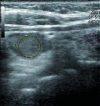Errors and mistakes in ultrasound diagnostics of the thyroid gland
- PMID: 26672970
- PMCID: PMC4579735
- DOI: 10.15557/JoU.2014.0006
Errors and mistakes in ultrasound diagnostics of the thyroid gland
Abstract
Ultrasound examination of the thyroid gland permits to evaluate its size, echogenicity, margins, and stroma. An abnormal ultrasound image of the thyroid, accompanied by other diagnostic investigations, facilitates therapeutic decision-making. The ultrasound image of a normal thyroid gland does not change substantially with patient's age. Nevertheless, erroneous impressions in thyroid imaging reports are sometimes encountered. These are due to diagnostic pitfalls which cannot be prevented by either the continuing development of the imaging equipment, or the growing experience and skill of the practitioners. Our article discusses the most common mistakes encountered in US diagnostics of the thyroid, the elimination of which should improve the quality of both the ultrasound examination itself and its interpretation. We have outlined errors resulting from a faulty examination technique, the similarity of the neighboring anatomical structures, and anomalies present in the proximity of the thyroid gland. We have also pointed out the reasons for inaccurate assessment of a thyroid lesion image, such as having no access to clinical data or not taking them into account, as well as faulty qualification for a fine needle aspiration biopsy. We have presented guidelines aimed at limiting the number of misdiagnoses in thyroid diseases, and provided sonograms exemplifying diagnostic mistakes.
Badanie ultrasonograficzne tarczycy pozwala na ocenę jej wielkości, echogeniczności, granic oraz podścieliska. Zobrazowanie nieprawidłowego obrazu ultrasonograficznego tarczycy, w połączeniu z innymi badaniami diagnostycznymi, umożliwia podjęcie decyzji terapeutycznych. Obraz ultrasonograficzny prawidłowej tarczycy nie ulega istotnym zmianom wraz z wiekiem pacjenta. Mimo to w obrazowaniu tego gruczołu zdarzają się błędne opisy, wynikające z obecności pułapek diagnostycznych, którym nie są w stanie zapobiec stałe udoskonalanie sprzętu oraz wzrastające doświadczenie badających lekarzy. W artykule przedstawiono najczęstsze pomyłki w obrazowaniu ultrasonograficzym tarczycy, których wyeliminowanie powinno przyczynić się do poprawy jakości badań i ich interpretacji. Omówiono błędy wynikające z niewłaściwej techniki badania, podobieństwa anatomicznych struktur sąsiadujących z tarczycą oraz nieprawidłowych zmian występujących w sąsiedztwie gruczołu tarczowego. Wskazano również przyczyny złej interpretacji obrazu zmian w tarczycy, takie jak brak dostępu do danych klinicznych albo nieuwzględnienie ich, a także błędne kwalifikacje do biopsji cienkoigłowej. Przedstawiono wskazówki dotyczące postępowania w celu zminimalizowania występowania pomyłek w rozpoznawaniu chorób tarczycy oraz zaprezentowano przykłady obrazujące błędy diagnostyczne.
Keywords: fine needle biopsy; medical mistakes; thyroid; thyroid diseases; ultrasound imaging.
Figures




















References
-
- Mohebati A, Shaha AR. Anatomy of thyroid and parathyroid glands and neurovascular relations. Clin Anat. 2012;25:19–31. - PubMed
-
- Polska Grupa ds. Nowotworów Endokrynnych. Jąrzab B, Sporny S, Lange D, Włoch J, Lewiński A, et al. Diagnostyka i leczenie raka tarczycy – rekomendacje polskie. Endokrynol Pol. 2010;61:518–568. - PubMed
-
- Bialek EJ, Jakubowski W, editors. Warszawa – Zamość: Roztoczańska Szkoła Ultrasonografii; Ultrasonograficzna diagnostyka tarczycy, przytarczyc i węzłów chłonnych szyi.
-
- Trzebińska A, Dobruch-Sobczak K, Jakubowski W, Jędrzejowski M. Standardy badań ultrasonograficznych Polskiego Towarzystwa Ultrasonograficznego – aktualizacja. Badanie ultrasonograficzne tarczycy oraz biopsja tarczycy pod kontrolą ultrasonografii. J Ultrason. 2014;14:49–60. - PubMed
-
- Patel BN, Kamaya A, Desser TS. Pitfalls in sonographic evaluation of thyroid abnormalities. Semin Ultrasound CT MR. 2013;34:226–235. - PubMed
Publication types
LinkOut - more resources
Full Text Sources
Other Literature Sources
